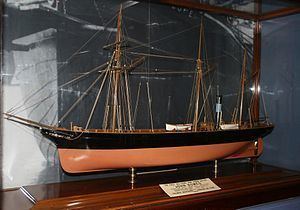Yard number 2 Completed 22 July 1852 Length 45 m Propulsion Steam engine | Port of registry United Kingdom Christened 30 June 1852 Launched 30 June 1852 Beam 7.8 m | |
 | ||
Builder Palmers Shipbuilding and Iron Company | ||
John Bowes, built on the River Tyne in England in 1852, was one of the first steam colliers. She traded for over 81 years before sinking in a storm off Spain.
Contents
Development
Owing to her success, the John Bowes is often said to be the first steam collier. That is not quite true. The Bedlington of 1841 could have that honour but she only worked locally (albeit in the open sea), she carried the coal in railway wagons (she was not a bulk carrier but a type of ferry) and she was wrecked in 1846.
The entrepreneur behind the John Bowes′ design was Charles Mark Palmer. She was the second vessel from his new Jarrow shipyard, founded with his brother George, which would build over a 1000 ships. The vessel's key novelties were the iron hull, water ballast and steam screw propulsion, despite which an auxiliary sailing rig was also fitted.
Career
Her working life started on 27 July 1852 with coal from the Tyne to London. Within the week, she had done the work of two collier brigs for a month and a stream of similar ships followed. Initially, the design of the ballast tanks proved problematical, as they could not be kept watertight, and Palmer tried a number of solutions before settling on longitudinal iron tanks beneath each hold designed by John McIntyre, manager of the Jarrow shipyard from 1853.
This first steam collier had a long and prosperous life. She was re-engined in 1864 and 1883. In 1873 John Bowes was sold to Benjamin Barnett and registered at London, and in 1896 to James Mackenzie ('John Bowes' Steamship Co Ltd) of Dublin. In 1898 she left the British flag on sale to Scandinavian owners as Spec and later Transit. In 1908 she was sold to Spain, where she traded for a further twenty five years as Carolina, Valentin Fierro and lastly Villa Selgas.
Demise
Whilst owned by Federico Fierro of San Sebastián and on a voyage from Bilbao to San Esteban de Pravia with an iron ore cargo, Villa Selgas encountered a storm in the Bay of Biscay and foundered off Ribadesella on 12-13 October 1933. It appears there was no loss of life.
